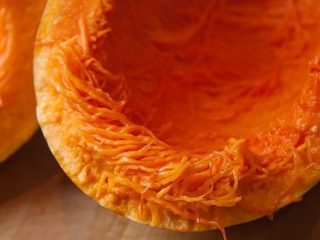Content
- 1 Is it possible to pumpkin while breastfeeding?
- 2 What are the benefits of pumpkin for a nursing mother and baby?
- 3 When and how to introduce it into the diet
- 4 How to cook pumpkin for a nursing mother
- 5 How to properly eat pumpkin dishes during breastfeeding
- 6 How to take pumpkin juice correctly while breastfeeding
- 7 Restrictions and contraindications
- 8 Conclusion
During lactation, it is very important to correctly compile a daily menu so that during milk production only the most beneficial substances are included in it. And if before pregnancy it was allowed to eat a variety of foods, then after childbirth the diet must be completely changed. During this period, you need to choose only hypoallergenic products with the most beneficial composition. You should eat fresh vegetables, fruits and berries with extreme caution. According to many nutritionists and pediatricians, pumpkin during breastfeeding is not only allowed, but also necessary, because it is low in calories, filled with useful microelements and is easily digestible.
Is it possible to pumpkin while breastfeeding?
When breastfeeding, it is necessary to carefully select foods when compiling the mother's daily menu so that only those microelements that benefit both her and her baby enter the nursing woman's body.As for melons, pumpkin can be consumed in moderation during breastfeeding, and it is allowed from the very first days after childbirth.
The body of a woman who has given birth accepts the orange fruit well. Pumpkin is easily digestible and promotes proper digestion. In very rare cases, the body may react negatively to its presence in the diet; this mainly occurs due to individual intolerance.
What are the benefits of pumpkin for a nursing mother and baby?
Pumpkin is a storehouse of useful vitamins, micro- and macroelements that help a woman regain her strength after childbirth. In addition, most of all the beneficial substances will certainly end up in milk and pass along with it to the newborn baby during feeding.
The composition of pumpkin is rich in fiber, which normalizes the activity of the mother’s gastrointestinal tract, eliminating constipation after childbirth.
The presence of beta-carotene improves a woman’s appearance, helps restore strength, and also has a good effect on the functioning of the skin and mucous membranes. The presence of potassium strengthens the cardiovascular system, normalizes its tone, reducing swelling. Magnesium, which is also contained in pumpkin, has a beneficial effect on the nervous system, which is the key to calm.
Most pediatricians also recommend consuming pumpkin when feeding a newborn with breast milk due to its ability to increase hemoglobin. The presence of elements such as copper, zinc, iron and cobalt makes the orange fruit a preventative against anemia. It is these elements that are involved in the synthesis of red blood cells.
Vitamins C, B, PP, K, which enter the body along with the consumption of this fruit, help strengthen the immunity of the mother and newborn during feeding.
Benefits of pumpkin juice during breastfeeding
Pumpkin juice, like the fresh fruit, contains all the microelements that help improve digestion and the appearance of a woman after childbirth, as well as reduce swelling and strengthen the immune system.
Freshly squeezed pumpkin juice does not contain allergens, which makes it absolutely safe for a newborn during feeding.
Drinking pumpkin juice during breastfeeding promotes proper metabolism in the mother's body. It has a diaphoretic and mild diuretic effect, which allows the body to get rid of toxins. In addition, this kind of liquid stimulates milk production, having a lactogenic effect during feeding.
When and how to introduce it into the diet
You can introduce pumpkin during breastfeeding as early as the 1st month after birth. Some pediatricians even allow its use from the first days of a child’s life. But in order for it to be extremely useful and not harmful, the following rules for its use must be observed:
- When introducing this fruit into the diet for the first time, it is advisable to limit it to no more than 50 g.
- It is better to eat pumpkin only in the first half of the day, and 1-2 hours after consumption it is necessary to monitor the condition of the newborn during feeding.
- If the child does not have any reaction to the new product, it can be consumed no earlier than one day later.
- If there is a positive effect on the mother’s body, as well as in the absence of a negative reaction in the newborn during feeding, the amount of pumpkin consumed can be gradually increased until the portion reaches the daily norm (200 g).
- Eating pumpkin during breastfeeding in the first month is recommended as part of porridge.
How to cook pumpkin for a nursing mother
During breastfeeding in the first month after birth, pumpkin can only be consumed in heat-treated form. But you should understand that it is not recommended to eat pumpkin fried, as well as to eat dishes that have been fried in oil or other fat. Such food is considered heavy and can have a bad effect on the pancreas of the mother and child during feeding, causing indigestion in the newborn, which causes colic. Therefore, it is better for a nursing mother to stock up on recipes for preparing pumpkin dishes by boiling, steaming or baking.
Pumpkin can be combined with cereals, other fruits, vegetables and berries. You can cook porridge, puree soups, casseroles, and steamed cutlets from it.
Fresh pumpkin can be eaten while breastfeeding only if the mother or child has been diagnosed with iron deficiency anemia. In this case, you need to consume no more than 1-2 small pieces of fruit per day. But if, when eating raw pulp, a child often experiences abdominal pain, colic and bloating after feeding, then the raw pumpkin should be replaced with juice.
Pumpkin porridge for a nursing mother
Ingredients:
- pumpkin – 200 g;
- millet – 0.5 tbsp.;
- milk (can be replaced with water) – 1.5 tbsp;
- salt, sugar - to taste.
Cooking method:
- Wash the pumpkin, remove the peel and seeds, cut into small cubes and boil in half the milk until tender (20-25 minutes).
- Sort the millet groats, rinse under running water and also boil until tender in the other half of the milk (15-20 minutes).
- Combine the boiled ingredients in a fireproof container, you can use a clay pot. Add salt and sugar to taste (a minimum amount of sugar should be used).
- Place in an oven preheated to 180 degrees for 10-15 minutes.
Pumpkin casserole when feeding
Ingredients:
- pumpkin – 100 g;
- millet cereal – 40 g;
- milk (water) – 50 ml;
- egg – 1 pc.;
- butter – 30 g;
- salt, sugar - optional.
Cooking method:
- The pumpkin is washed, peeled and cut into pieces. Lightly sauté in butter.
- Boil the millet until tender in milk or water (add salt and sugar to taste).
- Mix the prepared ingredients together with the egg.
- Place the pumpkin-millet mixture into a greased baking dish (you can sprinkle with a small amount of grated cheese if desired).
- Place in an oven preheated to 180 degrees for 30 minutes.
Creamy pumpkin soup during lactation
Ingredients:
- pumpkin pulp – 300 g;
- water – 500 ml;
- butter – 10 g;
- salt - to taste.
Cooking method:
- The peeled pumpkin pulp is cut into cubes.
- In a small saucepan, bring water to a boil.
- Add chopped pumpkin pulp and cook over low heat for 20-25 minutes.
- Salt to taste, mix and add butter.
- Remove from the stove and allow to cool.
- The cooled soup is ground using a blender until smooth.
How to properly eat pumpkin dishes during breastfeeding
Pumpkin dishes during breastfeeding can only be eaten in the first half of the day, preferably for breakfast. When starting to introduce this product into your diet, you should limit yourself to one serving per day. Closer to 3 months, you can already increase the number of servings to 2 per day. You should be careful with additives to the dish, in particular with honey, spices and sour cream. In large quantities, these components can cause an allergic reaction in the child after feeding.
How to take pumpkin juice correctly while breastfeeding
Pumpkin juice can be introduced into the diet of a nursing mother from the first week after birth. The main thing is to choose high-quality juice without additives or dyes. It's best to do it yourself.
It is recommended to use diluted pumpkin juice in the first month. This should be done with boiled water in a 1:1 ratio. Its dosage should not exceed 100 ml per day. Over time, you can reduce the amount of water, and closer to 3-4 months, stop diluting it altogether.
Restrictions and contraindications
Despite all the benefits of pumpkin for a woman during the feeding period, it still has its limitations and contraindications for use.
A large amount of this fruit can cause carotenemia in a child (the appearance of yellow pigmentation of the skin). It is not very dangerous for the health of the newborn when feeding, but in this case it is necessary to exclude pumpkin and other products containing beta-carotene for a long period (at least 30 days).
In addition, pumpkin is contraindicated for:
- low stomach acidity;
- disruption of the liver and pancreas;
- inflammation in the gastrointestinal tract;
- diarrhea.
In this case, eating pumpkin can exacerbate these processes.
Conclusion
Pumpkin during breastfeeding, if consumed in moderation, can have a positive effect on both the body of the nursing mother and the child. It allows you to replenish the necessary amount of microelements for proper recovery of the body after childbirth, as well as enrich breast milk with vitamins.













